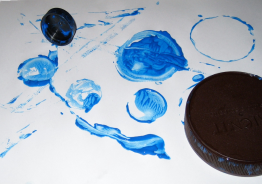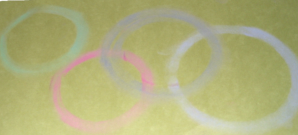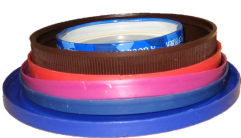There are so many fun ways to use jar lids and other lids for early learning. The best thing is that using them keeps them out of the landfill and doesn’t cost you a dime! They are even washable. If you work with younger children, just be sure that the lids are large enough not to cause a choking hazard. Whenever you buy jelly, jam, peanut butter, baby food, or other foods that come with lids, simply wash and save the lids. Ask the children’s families to save lids too and you’ll soon have a great collection. Here are 14 ways to use them for fun and learning:
Painting with Lids
 Pour puddles of paint into large plastic lids. The children can dip either the tops or bottoms of smaller lids into the paint and make prints on paper. Depending on which side they choose, the prints will look like rings or solid circles. They can also roll the edge of a lid in paint and then roll the lid along the paper to make lines. They may enjoy comparing the lines made by different lids. Encourage them to think of even more ways to use the lids for painting.
Pour puddles of paint into large plastic lids. The children can dip either the tops or bottoms of smaller lids into the paint and make prints on paper. Depending on which side they choose, the prints will look like rings or solid circles. They can also roll the edge of a lid in paint and then roll the lid along the paper to make lines. They may enjoy comparing the lines made by different lids. Encourage them to think of even more ways to use the lids for painting.
Individual Containers
Some lids make great individual containers for art materials, such as glue, paint, small beads, feathers, sequins, and more. Having their own individual containers gives children a sense of ownership and can prevent arguments and hurt feelings.
3-D Creations
Lids are great additions to sculpture and other three-dimensional art. If the children decide to design vehicles, lids make great wheels. They can also be glued to boxes to create control panels for any type of invention. They make good bases for clay creations.
Tracing Shapes
 Children can practice fine motor skills by tracing round lids with crayons, markers, colored pencils, chalk, or other drawing tools. They can add details to the circles to create flowers, faces, suns, or other images. They may also create colorful designs of overlapping circles. Another approach would be to lay them in a tray of sand or on paper coated with fingerpaint and trace them with a finger. An interesting technique is to rub a piece of chalk repeatedly on a scrap of paper to make a little dust. The child can place a lid on paper, dip a finger in the chalk dust and rub it around the edge of a jar lid to make a soft outline.
Children can practice fine motor skills by tracing round lids with crayons, markers, colored pencils, chalk, or other drawing tools. They can add details to the circles to create flowers, faces, suns, or other images. They may also create colorful designs of overlapping circles. Another approach would be to lay them in a tray of sand or on paper coated with fingerpaint and trace them with a finger. An interesting technique is to rub a piece of chalk repeatedly on a scrap of paper to make a little dust. The child can place a lid on paper, dip a finger in the chalk dust and rub it around the edge of a jar lid to make a soft outline.
Sorting
Because lids come in many sizes, colors, and designs, they are great for sorting. Children may sort by whether or not there are letters on the lid, how big around the lids are, how tall the lids are, the colors on the lids, whether they are metal or plastic, and in other ways.
Patterns
When you collect several types of matching lids, the children may use them to copy or create patterns. In the beginning, you can glue lids to strips of poster board to create simple patterns for the children to copy. As they grow in their understanding of patterns, they can create their own patterns.
Matching Jars to Lids
If you have plastic jars or bowls with lids, the children can fasten and unfasten the lids. If you have several sizes, the children can find out which lid fits each container.
Ordering by Size
Children may enjoy stacking lids inside each other or lining them up in order of size.
Weighing Lids
Lids are great to use with a balance scale. The children can place different lids on each side of the scale to see which are heavier. They can see how many lids of one type it takes to balance lids of another type. If you have a stack of lids that are the same, these can be used to compare weights or other materials. How many lids will balance a golf ball? How many are needed to balance a Ping-Pong ball?
Buoyancy
Add both metal and plastic jar lids to the water table. The children can explore to discover whether the lids float or sink. Encourage them to flip them right side up and upside down. Does the same thing happen? Can they make a floating lid sink? How? They may also use the lids to fill larger containers. They can observe what happens when they load a floating container with lids. Does the container still float?
Exploring Sounds
Drop plastic and metal lids into a mixing bowl or box and compare the sounds they make. Repeat with a different container. Do the lids make the same sound in the new container? You can also attach lids to string or yarn and hang them from a tree branch or the bar on a piece of playground equipment. The children can tap the lids with wooden spoons or other strikers to hear what sound they make.
L Is for Lid
Help the children notice the beginning sound of the word lid. What other words begin the same way? Make a long list of words that start with the /l/sound!
Make-Believe
Place a container of lids in your dramatic play area. You may be amazed at all the creative ways children may use them. They might use them as dishes, coins, play food, seeds, and more!
Playing Games
Create a variety of games using lids. Smaller lids make great tokens to move along paths on file folder games. You can use a larger plastic lid as the base for a spinner. Label small lids with X’s and O’s, create a grid, and you are ready to play tic-tac-toe. Lids can also be used for a variety of tossing games. Create targets from bowls or boxes and try tossing lids into them from different spots. Hide lids around the outside play area and see how many the children can find.
Have any of you found some great ways to use lids for learning? We’d LOVE to hear your ideas!
Back to blog listing